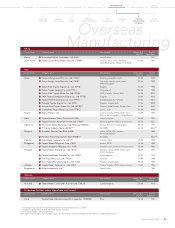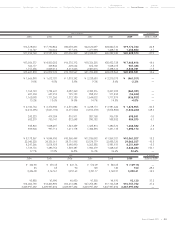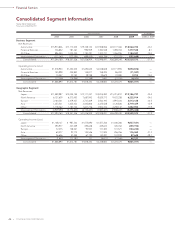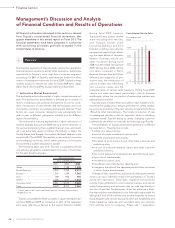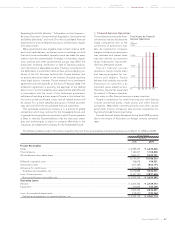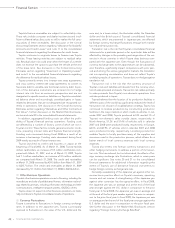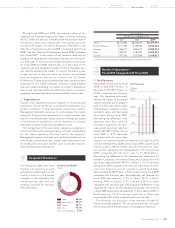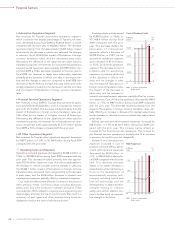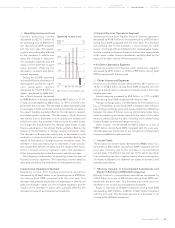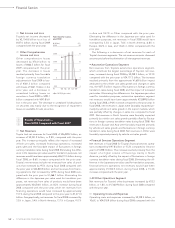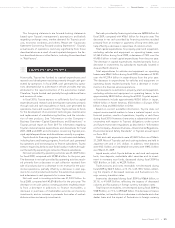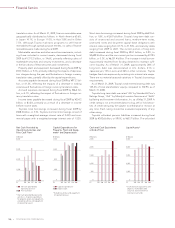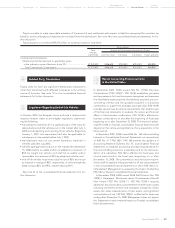Toyota 2009 Annual Report Download - page 51
Download and view the complete annual report
Please find page 51 of the 2009 Toyota annual report below. You can navigate through the pages in the report by either clicking on the pages listed below, or by using the keyword search tool below to find specific information within the annual report.
The Right Way Forward Business OverviewPerformance Overview Financial Section
Investor
Information
Management &
Corporate Information
Top Messages
Annual Report 2009 49
During fiscal 2008 and 2009, the average value of the
Japanese yen fluctuated against the major currencies including
the U.S. dollar and the euro compared with the average value of
the previous fiscal year, respectively. The operating results
excluding the impact of currency fluctuations described in the
“Results of Operations—Fiscal 2009 Compared with Fiscal
2008” and the “Results of Operations—Fiscal 2008 Compared
with Fiscal 2007,” show results of net revenues obtained by
applying the Japanese yen’s average exchange rate in the previ-
ous fiscal year to the local currency-denominated net revenues
for fiscal 2008 and 2009, respectively, as if the value of the
Japanese yen had remained constant for the comparable peri-
ods. Results excluding the impact of currency fluctuations year-
on-year are not on the same basis as Toyota’s consolidated
financial statements and do not conform with U.S. GAAP.
Furthermore, Toyota does not believe that these measures are a
substitute for U.S. GAAP measures. However, Toyota believes
that such results excluding the impact of currency fluctuations
year-on-year provide additional useful information to investors
regarding the operating performance on a local currency basis.
Segmentation
Toyota’s most significant business segment is its automotive
operations. Toyota carries out its automotive operations as a
global competitor in the worldwide automotive market.
Management allocates resources to, and assesses the perfor-
mance of, its automotive operations as a single business seg-
ment on a worldwide basis. Toyota does not manage any subset
of its automotive operations, such as domestic or overseas
operations or parts, as separate management units.
The management of the automotive operations is aligned on
a functional basis with managers having oversight responsibility
for the major operating functions within the segment.
Management assesses financial and non-financial data such as
units of sale, units of production, market share information, vehi-
cle model plans and plant location costs to allocate resources
within the automotive operations.
Geographic Breakdown
The following table sets forth
Toyota’s net revenues in each
geographic market based on the
country location of the parent
company or the subsidiary that
transacted the sale with the
external customer for the past
three fiscal years.
Results of Operations—
Fiscal 2009 Compared with Fiscal 2008
Net Revenues
Toyota had net revenues for fiscal
2009 of ¥20,529.5 billion, a
decrease of ¥5,759.7 billion, or
21.9%, compared with the prior
year. This decrease principally
reflects the impact of decreased
vehicle unit sales and changes in
sales mix, the unfavorable impact
of fluctuations in foreign currency
translation rates, and decreased
parts sales during fiscal 2009.
Eliminating the difference in the
Japanese yen value used for
translation purposes, net reve-
nues would have been approxi-
mately ¥22,560.7 billion during
fiscal 2009, a 14.2% decrease
compared with the prior year.
Toyota’s net revenues include net revenues from sales of prod-
ucts that decreased by 22.8% during fiscal 2009 compared with
the prior year to ¥19,173.7 billion and net revenues from finan-
cial services operations that decreased by 7.7% during fiscal
2009 compared with the prior year to ¥1,355.8 billion.
Eliminating the difference in the Japanese yen value used for
translation purposes, net revenues from sales of products would
have been approximately ¥21,011.3 billion, a 15.3% decrease
during fiscal 2009 compared with the prior year, while net reve-
nues from financial services operations would have been
approximately ¥1,549.4 billion, a 5.5% increase during fiscal 2009
compared with the prior year. Geographically, net revenues for
fiscal 2009 decreased by 11.2% in Japan, 34.1% in North
America, 24.0% in Europe, 12.2% in Asia and 20.1% in Other
compared with the prior year. Eliminating the difference in the
Japanese yen value used for translation purposes, net revenues
in fiscal 2009 would have decreased by 11.2% in Japan, 24.9% in
North America, 13.1% in Europe, and 0.4% in Other and
increased by 0.9% in Asia compared with the prior year.
The following is a discussion of net revenues for each of
Toyota’s business segments. The net revenue amounts discussed
are amounts before the elimination of intersegment revenues.
Net Revenues
0
6,000
12,000
18,000
24,000
30,000
(¥ Billion)
’08’07 ’09’06’05FY
Revenues by Market
FY2009
Japan 36.4%
North America 29.7%
Europe 14.1%
Asia 11.9%
All Other Markets 7.9%
Yen in millions
For the years ended March 31,
2007 2008 2009
Japan .......................... ¥8,152,884 ¥8,418,620 ¥7,471,916
North America ........... 8,771,495 9,248,950 6,097,676
Europe ........................ 3,346,013 3,802,814 2,889,753
Asia ............................. 1,969,957 2,790,987 2,450,412
Other* ......................... 1,707,742 2,027,869 1,619,813
* “Other” consists of Central and South America, Oceania and Africa.


